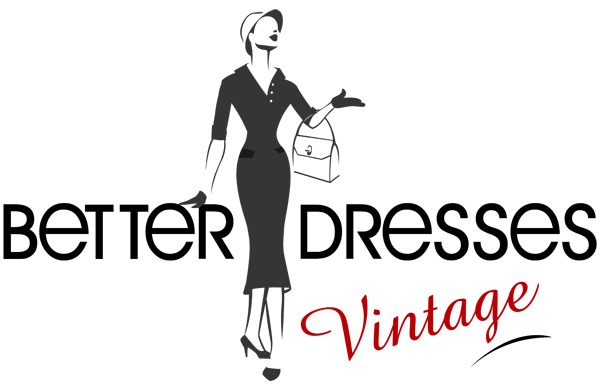The Fitting Room
A WORD ABOUT SIZING
When it comes to buying vintage, size really doesn't matter! Instead, we place the item into one of three fairly broad categories (small, medium, large), based on its measurements. This allows you to search by size to narrow your choices to those most likely to fit, and exclude those that almost certainly won't.
But then it's up to you to read the detailed garment measurements we provide.
Vintage isn't one-size-fits-all, and our items don't come in other sizes. They're one-of-a-kind, like you! To avoid disappointment and the hassle of returns, keep reading.

HOW DO I KNOW IF SOMETHING WILL FIT ME?
You can measure yourself or you can measure a similar item you already own that fits you well. Here's how:
Measure Yourself (or ask a friend or tailor to help) - Wear only your properly fitting undergarments. Stand up straight. Don't hold your breath or pull the tape tight.
Bust: Measure around the fullest part of the breasts over a good-fitting bra. Keep the tape horizontal (not higher or lower in back). This is not your bra band size!
Ribs: Measure around your body just under the breasts. This is important if an item is very fitted through the torso.
Bodice: Measure from the high point of your shoulder (close to your neck) and down over your bust to your natural waist.
Waist: Measure around the smallest part of your middle. Don't suck in your stomach or hold your breath. Your waist is above your bellybutton, not at or below it.
Hips: With legs together, measure around the fullest part of your bottom and thighs, about 8-9" below your waist.
Measure each area twice, write the numbers down so you can refer to them while shopping. Repeat the process if you lose or gain more than a few pounds, or at least every year.
Our listings include the garment's actual measurements. Be sure these numbers are a bit bigger than your body's measurements (this bit of breathing room is called "ease").
OR
Measure Something You Already Own That Fits You Well - Simply measure your well-fitting garment the same way we do, as described below.
When shopping using your clothing's measurements, there's no need to add any extra room. Just match your numbers with our numbers for a good fit.

HOW WE MEASURE OUR GARMENTS
Clothing - Taken with garment lying flat and unstretched on a hard surface, as follows:
- shoulder: from shoulder seam to shoulder seam, at the very top of the garment (not across the middle back)
- bust: at widest point of chest, under armpits, and doubled -- does not necessarily include space for breasts created by any darts, which will be noted separately if significant
- ribs: below the bust, at the top of the rib cage, where a bra band would sit, and doubled
- bodice: from top of shoulder, down front of garment to waistband (especially important if you have a short or long torso)
- sleeve: along the outer edge of the sleeve from shoulder seam to end of cuff
- waist: at the narrowest point, or, for loose-hanging garments, at the approximate natural waistline, and doubled
- hip: usually 8-9" below natural waist, and doubled
- length: from shoulder top to hem on the front (or from nape of neck to hem on back, as noted)
- skirt length: from top of waistband to hem edge
- hem sweep: across bottom of fully-extended skirt and doubled
-
rise: from front waistband to crotch seam
- inseam: from crotch down inside of leg to hem edge
- length: on interior from tippy toe (where, in pointy shoes, no human toe actually reaches!) along insole to heel
- width: on interior across widest point of the ball of the foot
- heel height: at back of shoe from floor to top of heel
All Other Items - Measurements are taken as indicated in the item's description.

We're happy to help you determine if a particular item will fit you. Just email or call us at 404/320-9226 (ET, GMT-5).
One last bit of advice: If you love a particular item but the measurements are off, keep in mind that most items can be altered to fit by a professional seamstress or tailor. Taking in a too-big item is usually easier and less expensive than letting out a too-small item.

